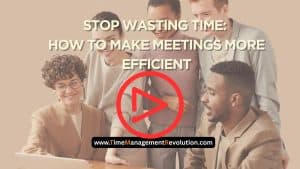Stop Wasting Time: How to Make Meetings More Efficient

Many of my clients detest meetings because they can be such a waste of time. Some meetings consist of waiting around for people to show up, only to run out of time and rush to decide when the next meeting will be.
Turn meetings into momentum. Use a rapid-fire format to boost clarity, cut interruptions, and give your team time back. If you want to stop wasting time and learn how to make meetings more efficient, click the graphic to watch my recommendations or scroll down to read:
(an excerpt from a keynote to NASBP in Arizona)
If you don’t have to prepare to go to a meeting, then it’s not a meeting; it’s a presentation. So, I recommended to my client that his team members had to walk into their 1:1’s with:
*what all of their wins had been since the last time they met
*their accomplishments (really fast, rapid fire, 30 seconds)
*the answer to: “What do you have in your pipeline that you’re going to be working on over the next few weeks?”
*the answer to: “How can I support you with that?”
Those became his one-to-ones, and they were much more effective and cut down on the micromanaging he felt that he needed to do, which gave his team time back. He went ahead and started implementing (I know you’re going to give me an eye roll when I tell you this recommendation) a weekly department meeting.
I usually get an eye roll when I recommend that because people complain, “Oh my gosh, another meeting? Do you know how stupid meetings are?” Usually, we call a meeting stupid if it’s not productive. But if you run it the way I’m going to share with you, they are productive.
This is for a department with 15 or fewer people. It should not take more than 30 minutes for a status meeting or a quick department meeting. First, on your agenda that you send out ahead of time, if your meeting is going to start at 2:00, your agenda should state, “1:50 to 2:00, visiting.” It’s very clear that the visiting is going to happen before the meeting, because at 2:00, you’re going to start that meeting.
When you wait for people who are late, what are you training them to do? Be late. “We’re going to wait for you. You just show up whenever you want to.” So start that meeting at 2:00. Then you have the timeframes on your agenda divided out based on how many people you have in your department.
Similar to a 1:1 I described above, here’s the format for a more efficient meeting:
*Round one, what have you cleared from your plate? What are your celebrations? Rapid fire around the room, 10, 15 seconds each. If you’re doing this weekly, it should not take very long, and everybody knows they have to walk in prepared. They don’t sit there and try to think of what they’ve accomplished.
*Round two, what do you have in your pipeline coming up over the next several weeks that you’re going to be working on?
*Round three is absolutely critical: What do you need from whom by when? I repeat, “What do you need from who by when?” This helps cut back on the interruptions and those so-called emergencies. It’s impossible to get rid of those 100%, but you can at least cut back on them.
*Save questions for the end. The reason why you do this is because sometimes the questions that arise come from either people who were not fully paying attention or they’re introspective and they have a bit of delay on processing information.
By saving your questions for the end, those people who need to leave at that hard stop time of 2:30 can go out the door, and those with questions can stay behind and talk to the team leader. Usually if it was a super critical question, it would’ve been asked in that moment when somebody’s sharing, “This is what I need from you by this time.”
If you run your meetings efficiently and effectively, your team will stop losing time and will cut back on those interruptions that you have in the office.
For recommendations on how to live this time management philosophy, check out The Inefficiency Assassin: Time Management Tactics for Working Smarter, Not Longer.


